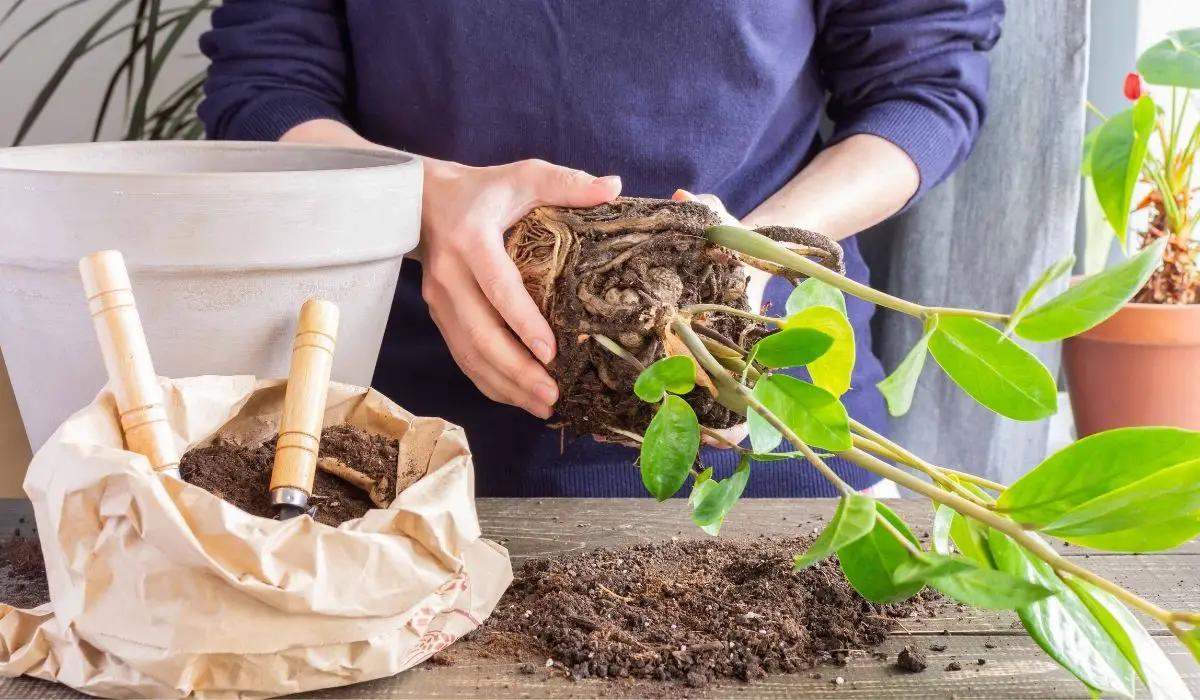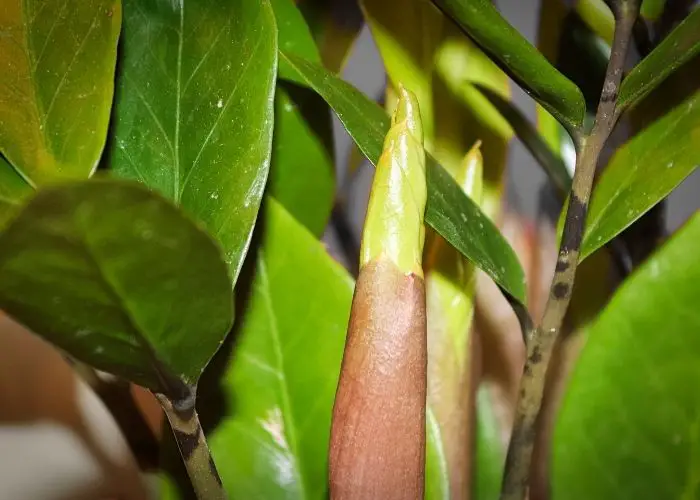Last Updated on January 23, 2022 by Fabiola L.
Having your ZZ plant root bulb exposed leads to damages caused by temperature changes, pests, lack of nutrients, and dehydration. Zamioculcas zamiifolia is easy to grow, a low-maintenance plant that’s highly decorative.
Its roots are something between bulbs and tubers. They’re called rhizomes and are modified stems that stay underground. They store all the nutrients, food, and moisture the plant needs to survive. With improper care, these bulbs can get exposed. This makes them prone to damage and the plant can eventually die.
Luckily the ZZ plant is hardy and forgiving. Read why is the ZZ plant root bulb exposed and how to prevent it in the future.
Quick Facts About The ZZ Plant Roots
Unlike bulbs, rhizomes are flat, irregularly shaped, and grow horizontally. Think of the shape of ginger – the ginger root is a rhizome! Rhizomes and bulbs have the same task, protecting the plant and storing food. They’re both underground stems but differently shaped. One famous bulb is garlic.
The rhizome can withstand harsh weather conditions, making the ZZ plant hardy and tolerant. But when something gets the ZZ plant root bulb exposed, the whole plant is under threat.
Is My ZZ Plant Root Bulb Exposed Due To Disease?
Disease won’t get the ZZ plant root bulb exposed. But it can easily reach the bulb once it’s uncovered. ZZ plant rhizomes don’t get buried deeply, as they can suffer in soggy soil and eventually rot. However, when the rhizome is exposed for a longer period, it can also decay. You’ll notice how the deep color turns lighter and finally yellow. The rhizome then gets mushy and soft.
Why Are My ZZ Plant Bulbs Exposed
While some gardeners advise leaving a small section of the bulb exposed, we suggest covering it with at least an inch of soil. So what got the ZZ plant root bulb exposed? Basically, these are the main reasons.
Overwatering
Zamioculcas zamiifolia is a drought-tolerant succulent and doesn’t need frequent watering. You should also plant it in a pot with drainage holes. If you tend to water the ZZ plant more often, some soil will get blended with the water and released through the drainage holes. As the soil level drops, the bulb gets exposed.
Unsuitable Gardening Hose
In USDA Hardiness zones 10 to 12, you can plant the ZZ plant outside. Outside plants are often watered with hoses. You can easily remove the thin layer of soil when watering the ZZ plant with a higher pressure hose. This leaves the ZZ plant root bulb exposed and prone to pests.
Container Size
ZZ plants don’t need large containers but don’t keep them in their first pot for years. The soil can be insufficient as the plant grows, and the bulb can quickly get exposed.
Ceramic Planter Pot with Drainage Hole and Saucer
Root Bound ZZ Plant
ZZ plants are prone to root bounding. While the plant is a slow grower, the rhizomes grow faster horizontally and fill up the pot. The roots of the rhizomes grow only downwards and can push up the bulb. Since they’re shallow planted, you’ll notice the top of the rhizomes coming up.
The plant doesn’t outgrow containers quickly, but the rhizomes can be a good reason to transplant them more often.
ZZ Plant Bulb Exposed – What To Do Now?
No matter what got the ZZ plant root bulb exposed, there is a way to fix it. It’s important to act fast to prevent the chances of root rot or any pests reaching the rhizome.
Change The Watering Equipment And Schedule
Watering depends on where you keep your ZZ plant. However, as it’s often used as an indoor and office plant, we’ll consider watering in these conditions. You need to water the plant once a large section of the soil is dry, or every 2 to 3 weeks. Remember that the rhizome stores moisture, so skipping a watering won’t kill the plant.
Water thoroughly until water starts coming out of the drainage holes. Empty the saucer afterward. Use a cup or watering can instead of a hose.
Repotting In Bigger Pot
The pot size of the ZZ plant shouldn’t be too big or too small. A small pot leads to bulb exposure and root bounding, but a big one can lead to root rot. Pick a middle-sized pot and replant it once you can feel the bulbs near the pot’s walls.
Divide The Bulbs
ZZ plants are more appealing when two or more bulbs are planted together. If you got your plant as a gift or purchased it because it looked great, there might be more rhizomes under the surface. This can be what gets the ZZ plant root bulb exposed.
To divide them, start by putting on gloves as the ZZ plant’s sap can irritate the skin.
- Don’t water the plant for 2 weeks before dividing the rhizomes.
- Remove the plant from the pot and run it under water to remove any soil clumps.
- Place the bulbs on a flat surface and try to divide them by hand. You can trim the roots using a clean, sterilized knife or shears.
- If the bulbs are too close together, use the knife to gently divide them.
- Plant the bulbs separately in suitable pots and water. Don’t worry if some leaves turn yellow or fall off in the first week.
Common ZZ Plant Problems
Overwatering is the main problem ZZ plant owners face. It leads to stems collapsing, root rot, yellowing of the leaves. ZZ plants benefit from filtered sunlight and dappled shade but won’t grow in full shade. In addition, low humidity and high temperatures can cause leaf browning.
Pests like aphids love the ZZ plant’s sap and will often munch on the leaves, leaving yellow marks.
Bottom Line: ZZ Plant Root Bulb Exposed
Common negligence can get ZZ plant root bulb exposed. While it’s not anything to get worried about, it’s good to prevent it. An exposed bulb can be easily attacked by pests or rot over time.
Check your watering method, schedule, and equipment. Make sure the pot is a suitable size, and the bulbs are comfortable inside, not hitting the walls. The ZZ plant is a hardy plant but occasionally requires your attention.
Mary is a passionate gardener who loves spending her days getting her hands dirty and nurturing her plants. She‘s an avid reader of gardening magazines and is always looking for new ways to make her garden thrive. When not outside tending to her plants, Mary can be found inside reading up on the latest gardening trends, comparing notes with fellow gardeners, and finding the perfect pottery planter for her next planting project.



